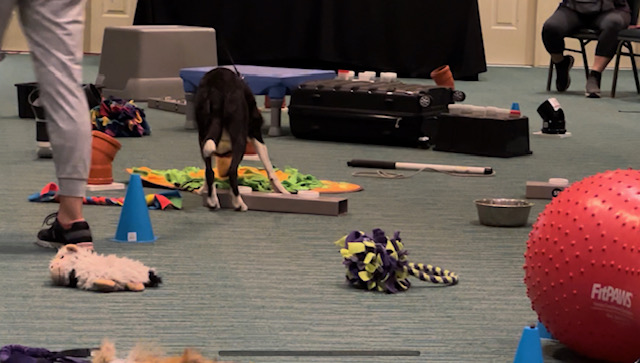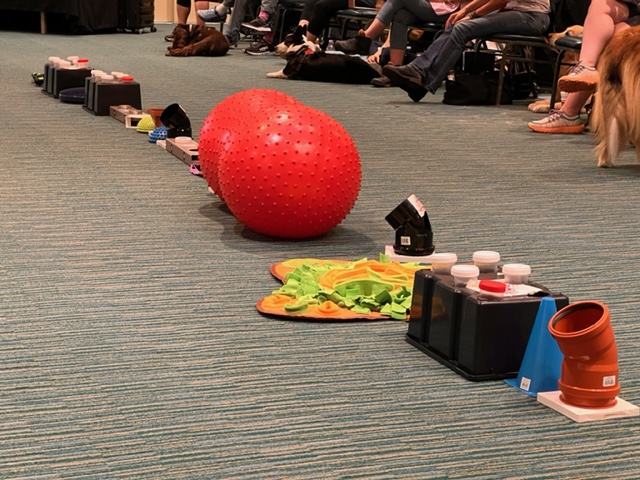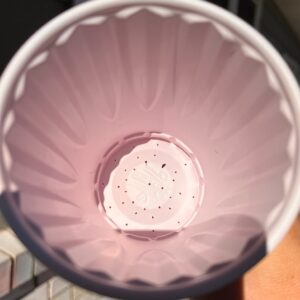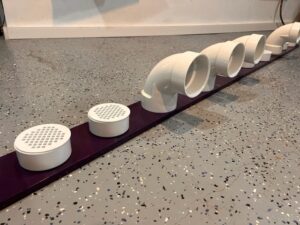Barks Blog
Canine Enrichment with Scent Detection
By Emily Coleman
In early November 2022, my dog Deja and I journeyed off to the sunny climes of Crystal River, Florida, in search of adventure! And odor … By this I mean we attended the Pet Professional Guild’s three-day Scent and Scentability workshop.
Expert detection-dog handlers Dr. Robert and Karen Hewings, both retired professional police dog handlers, provided loads of valuable insight. Robert and Karen now run the UK College of Scent Dogs and were kicking off an international tour. In total, they presented five days of quality scent detection instruction. Deja and I attended the first three days, which centered around a variety of interdisciplinary applications for sniffing. The research Dr. Hewings presented suggests that intentionally utilizing dogs’ noses significantly improves their quality of life.

SNIFFING IS A BASIC NEED
Dr. Hewings dispelled several myths about the scentability of dogs. One study he presented compared the olfaction capabilities of pugs and German shepherds. The conclusion may surprise you! Study designers found that “pugs outperformed German shepherd dogs in acquiring an odor discrimination and in detecting lower concentrations of the target odorant” (Hall et al., 2015). The dogs’ vision was about the same. This demonstrates that all dogs benefit from the incorporation of scent activities into their regular routine. You don’t need a dog with a long, pointy nose to enjoy scent detection exercises.
Dr. Hewings also explored the benefits of sniffing as it relates to the most important instinctual system—the seeking system. The act of seeking is more pleasurable to dogs than the act of obtaining. Dogs in search are focused, mindful and able to process a significant amount of information. Seeking is a basic need and lack thereof is detrimental to dogs. If seeking were added to Maslow’s Hierarchy of Needs, it would likely fall under the physiological needs portion along with other basic needs like food, water and sleep. A dog in search of something is likely free of intense states of fear, rage, panic or grief.

SNIFFING MAKES DOGS OPTIMISTIC
Scent detection is a great tool for mental enrichment. Another study concluded that “allowing dogs to spend more time using their olfaction … makes them more optimistic” (Duranton & Horowitz, 2019). Your dog’s energy is far more effectively spent when searching for treats instead of being given treats. Scatter feeding is a simple way of providing foraging opportunities for dogs. Sprinkle the dog’s kibble in a small area of grass or hide treats amid retaining wall bricks. Snuffle mats for feeding enrichment allow the dog to sniff throughout the toy to find the various treats.
While on the road, we make a game of hiding Deja’s treats around the RV. This keeps her busy when we can’t take her inside a venue, such as a restaurant. We also stuff and freeze her raw diet in Kongs for additional enrichment. Behavioral issues are a direct result of an unmet need, and scent detection helps fill this void.
SNIFFING REDUCES STRESS
Activating your dog’s seeking system proves beneficial in a wide range of applications. Finding tasty food gives puppies confidence and puts dogs at ease in new environments. You can incorporate the search for treats around the introduction of novel items for puppy socialization. Several of the dogs at the workshop visibly calmed while engaged in sniffing activities, and the dogs maintained their focus on sniffing while doors opened nearby or other dogs barked.
In this video, my dog Deja learns to search persistently by finding treats hidden down the row of search equipment. (Video © Emily Coleman)
Often at the beginning of an initial consultation, new dogs require a period of acclimation before they are ready to take treats. We encourage owners to walk with their dog as the dog sniffs and explores the space. As they walk, we ask the owner to place treats ahead of the dog for them to seek and find. It’s okay if the dog doesn’t eat the treats. Once the dog feels confident enough to eat the food, they’ll remember where any treats they’d skipped were placed and eagerly return to them. They’ll also engender great anticipation for future food discoveries. In this manner, the dog relaxes and learns that the environment is a splendid place to be, and feels safe and happy.
INCORPORATING SCENT DETECTION INTO YOUR DAY
Additionally, utilizing the seeking system is great for older dogs and dogs on crate rest. Present novel odors in familiar toys to refresh old items. Dogs often seek certain herbs for digestive discomfort or skin ailments. A variety of plants are safe for dogs to explore such as lavender, birch, marigold, meadowsweet, catnip, peppermint, valerian, willow and wheat grass. Experiment with certain scents and see which ones your dog likes. If he turns his head or avoids a certain odor, simply remove it from the rotation. This gives your dog something to do to keep from going stir crazy. Use your dog’s regular food ration to ensure they aren’t bulking up on extra training treats while on crate rest.
You can also pair a particular scent with something your dog finds intrinsically motivating like food. I began teaching Deja that clove was the target odor by placing a Q-tip saturated with clove oil inside a plastic Solo® cup and another Solo® cup inside that cup. The inside cup had perforations in the bottom to allow the odor molecules to escape. When Deja held her nose in the cup, I clicked and delivered a treat. Now she’s progressing to differentiating between identical cups and indicating which cup is concealing the target odor.


We are also using a scent box and a scent board to condition Deja to clove oil, but this equipment can be used to condition any target odor.


TAKING SCENT DETECTION TO ANOTHER LEVEL
Of course, many enjoy scent detection as a sport or hobby. Many workshop attendees were well versed in the discipline of scent work and stayed for the advanced handling workshop. Deja, being new to us and to scent work, was not quite ready for those advanced techniques. In the United States, the common scents used in competition are clove, birch and anise. The odor is concealed in the search environment, and the dog must indicate the source of the odor. In the United Kingdom, other scents used include gun oil and truffle oil. One handling team in attendance at the workshop was training their black lab puppy on human scent for search and rescue.
In this video, Deja learns to alert to the presence of the odor by pointing to it with her nose. Feet don’t count! (Video © Emily Coleman)
All in all, Deja and I learned a lot from Dr. Hewings and Karen, and we are excited to begin incorporating our new knowledge for the benefit of our relationship and clientele!
References
Duranton, C., & Horowitz, A. (2019). Let me sniff! Nosework induces positive judgment bias in pet dogs. Applied Animal Behaviour Science, 211, 61–66. https://doi.org/10.1016/j.applanim.2018.12.009
Hall, N. J., Glenn, K., Smith, D. W., & Wynne, C. D. L. (2015). Performance of pugs, German shepherds, and greyhounds (Canis lupus familiaris) on an odor-discrimination task. Journal of Comparative Psychology, 129(3), 237–246. https://doi.org/10.1037/a0039271

Emily Coleman is the owner of Canine Solutions in Spring Hill, Kansas. As a certified professional dog trainer and bully breed enthusiast, Emily has been serving the needs of local dog owners since 2009.
To maintain her credentials, Emily attends multiple educational seminars and learning opportunities each year and is committed to providing her clients the most current, science-based instruction available. Raised in Prairie Village, Kansas, Emily received her associate of arts degree from Johnson County Community College in 2005 and a bachelor’s degree in liberal arts from the University of Missouri-Kansas City in 2008.
Together with her husband, Christian, Emily gives back to her community by fostering shelter dogs, promoting responsible dog ownership and handling at community events, and providing educational opportunities about living safely with dogs. In their free time, Emily and Christian grapple in Brazilian jiu jitsu. They have a husky mix named Deja, who serves as a demonstration and decoy dog. They also have three young daughters who love helping their mommy train dogs!
